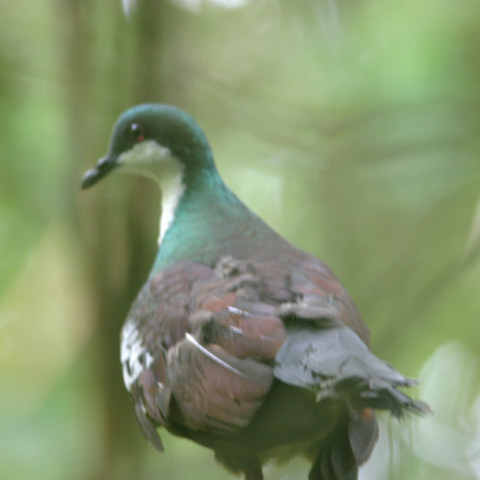Conservation Actions
Conservation Actions UnderwayCITES Appendix I. An Action Plan was published for this species in 2015 (Pham Tuan Anh and Le Trong Trai 2015). Surveys for the species were conducted in 1988, 1991 and 2011. The localities from which the most recent records derive have been incorporated within two proposed nature reserves, Phong Dien and Dakrong, for which a management feasibility study has been completed. A Site Support Group has been established for Dakrong IBA (Quang Tri) and there are plans for one at Huong Hoa IBA (Quang Tri) (J. Eames in litt. 2004), where Bach Huong Hoa Nature Reserve was proposed. Bach Ma National Park lies within the historical range of the species, and a poster campaign to obtain local information was conducted there in 1996, although as yet there have been no confirmed records from this park. In December 2003, the captive population numbered 1,033 individuals (A. Hennache in litt. 2004). The maternal line has been screened and hybrids purged from the captive stock (A. Hennache in litt. 2004). Further camera-trapping surveys were planned to take place at Truong Son forest enterprise and Phong Dien NR (and an adjacent area in Hai Lang district), Quang Tri, in early 2012 (Pham Tuan Anh in litt. 2012). Poster distribution and community interviews have occurred since 2014 around Trurong Son, but there has been little information gained from these about the persistence of the species there, although further surveys have been planned (Pham Tuan Anh and Le Trong Trai 2015).
Conservation Actions Proposed
Use remote sensing to classify forest according to humidity in order to identify potentially suitable areas for the species within the remaining forest matrix (Mahood et al. in prep.). Conduct further surveys of remaining forest fragments within and to the north of its historical range using camera trapping and specially trained dogs (Mahood et al. in prep.), particularly at areas identified through modelling approaches (e.g. Grainger et al. 2017), to clarify the species status and ecological requirements. Establish the proposed Phong Dien and Dakrong Nature Reserves, encourage the protection of other key sites for the species (Pham Tuan Anh and Le Trong Trai 2015) and enhance Site Support Groups. Promote careful management of captive Vietnamese Lophura pheasants through the ISB system, and regularly review ex-situ measures until their taxonomic relationships are clarified. If appropriate, utilise the captive population to prepare suitable individuals for reintroduction (Pham Tuan Anh and Le Trong Trai 2015). Prepare a landscape level management plan to redress genetic problems caused by habitat fragmentation and establish effective habitat protection. Assess the level and impact of hunting and campaign for its control, starting with complete cessation in protected areas holding the species. Conduct research to establish the feasibility and effects of using forest corridors to connect forest fragments.
Location Information
Lophura edwardsi is endemic to central Vietnam. Known historically from four provinces (Ha Tinh, Quang Binh, Quang Tri and Thua Thien Hue), it was formerly described as locally fairly common. Individuals were recorded near to the Phong My Commune, Thua Thien Hue, and also near the Huong Hiep Commune, Quang Tri (Le Trong Trai et al. 1999). Several other individuals were found in the Quang Tri and Thua Thien Hue Provinces, but the last confirmed recent record was in 2000, where one male was confiscated from a hunter and held in captivity in the Hai Lang District Forest Protection Department, Quang Tri. Between 1964 and 1994, there were >30 records of the species, with a further record in 1999 (R. Safford in litt. 2015). In 2009, an additional female was recorded near Hai Van Pass, but there are doubts about the identification (A. Hennache in litt. 2012). In 2011, dedicated camera-trap surveys for the species in two relatively undisturbed sites, Khe Nuoc Trong Watershed Protection Forest and Quang Binh and Dakrong Nature Reserve, Quang Tri, failed to record the species (Le Trong Trai in litt. 2012). Lophura 'hatinhensis', which was previously described as a species, is a mutation of L. edwardsi that has been observed at either end of, and within the known range of, L. edwardsi (J. Eames in litt. 2012, Hennache et al. 2012). The occurrence of birds showing inbred characteristics since the 1960s and the lack of any recent records of the species are an indication that remaining populations are extremely small, fragmented and declining. Pessimistic scenarios even estimate that the species may have gone extinct in the wild in the early 2000s (Grainger et al. 2017).
Geographic Range
Extant
Viet Nam
Population Information
The complete lack of records since 2000 suggests that any remaining wild population is now tiny (S. Mahood in litt. 2012), and it has even been suggested that the species may already be extinct in the wild. The captive population numbers more than 1,000 individuals. In the absence of better data, the population is placed here in the band 50-249 mature individuals. Any remaining subpopulations are likely to be extremely small and declining.Threats
Its historical range is now almost completely denuded of primary forest through a combination of herbicide spraying during the Vietnam war, logging and clearance for agriculture. The last forested areas known to support the species are subject to continuing degradation by wood-cutters. Small patches of very humid forest, embedded in a matrix of unsuitable forest, are only likely to maintain their high humidity values when large areas of forest remain intact. Forest fragmentation in the hills above the now deforested coastal plain has been more intense than forest loss, but is likely to have caused an overall drying of the forest, which might have rendered formerly suitable patches of forest unsuitable (S. Mahood in litt. 2012). Whilst the species has been recorded in degraded habitats, it is uncertain whether it is able to persist in such conditions the long term (W. Duckworth in litt. 2012). Hunting pressure from collectors of various forest-products poses a major threat, and the species may be affected by indiscriminate snaring (N. Brickle in litt. 2004). Although galliformes can withstand extremely high levels of trapping (Brickle et al. 2008), they can be locally eliminated. Because trapping is indiscriminate and targeted at more resilient species of ground-dwelling birds such as Red Junglefowl Gallus gallus, it continues when numbers of other species such as Edwards’s Pheasant are severely reduced and uneconomically viable as a single species harvest. Through this mechanism, populations can be trapped to local extinction (BirdLife International 2001).Partners
IUCN Red List Account Link
Please click here to see the species' IUCN Red List Account page.Photo Credits
Ariel Jacken (featured image)
Roland Wirth (category image)









